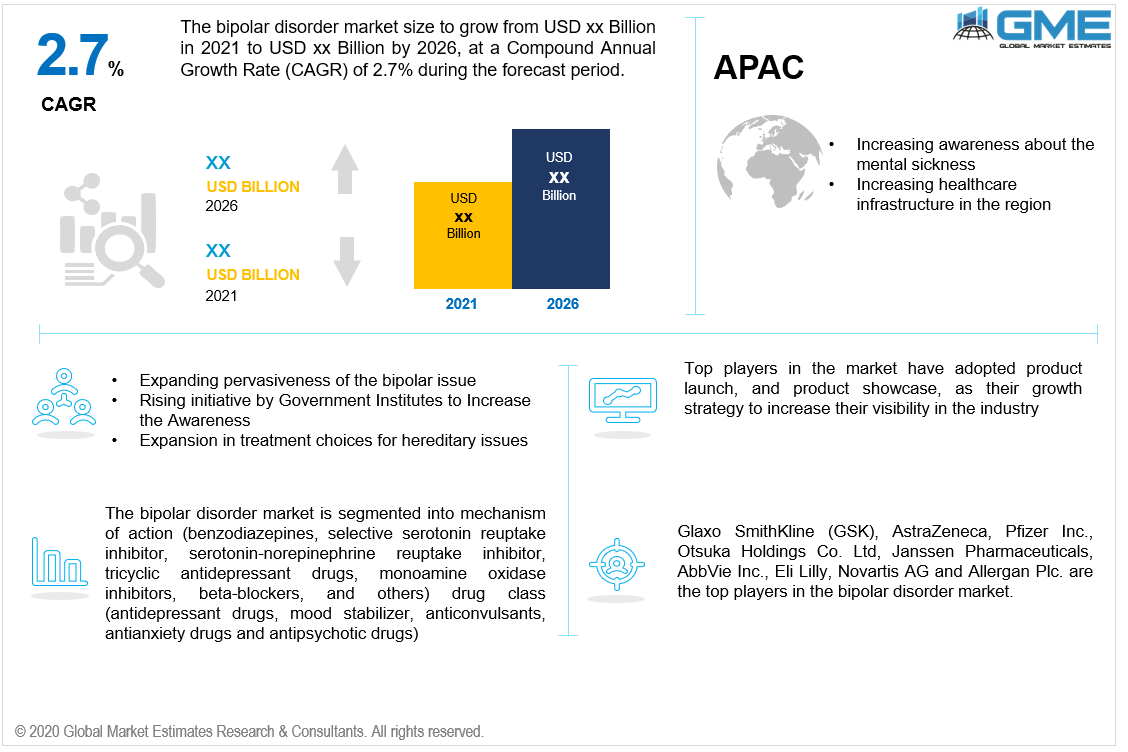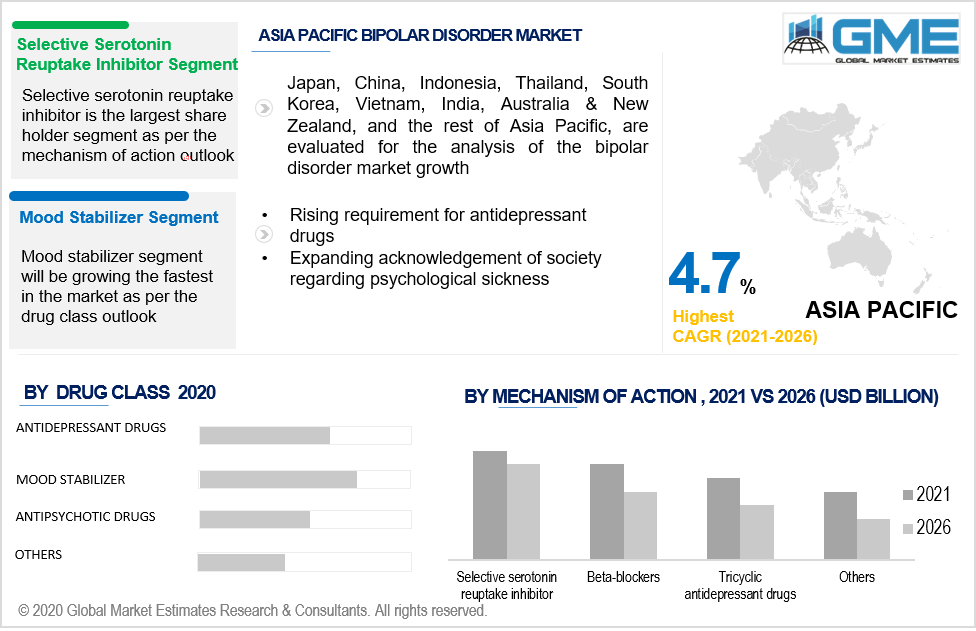
Global Bipolar Disorder Market Size, Trends & Analysis - Forecasts to 2026 By Mechanism of Action (Benzodiazepines, Selective serotonin reuptake inhibitor, Serotonin-norepinephrine reuptake inhibitor, Tricyclic antidepressant drugs, Monoamine oxidase inhibitors, Beta-blockers, Others) By Drug Class (Antidepressant drugs, Mood stabilizer, Anticonvulsants, Antianxiety drugs, Antipsychotic drugs) By Region (North America, Asia Pacific, CSA, Europe, and the Middle East and Africa); End-User Landscape, Company Market Share Analysis & Competitor Analysis
In the projected period, technological developments and the acceptance of a sedentary lifestyle are anticipated to propel the growth of the bipolar disorder treatment market. Also, expanding factors such as genetics and the environment may affect brain structure and chemistry, leading to the development of bipolar illnesses, which would enhance numerous prospects, resulting in the growth of the bipolar disorder treatment market over the projection period. People are being encouraged to seek treatment as society's awareness of mental illness grows, along with advancements in the mix of pharmaceuticals. Furthermore, the increasing demand for antidepressant medications is propelling the global bipolar disorder market forward.
Bipolar disorder is becoming more common, as evidenced by many risk factors such as high blood pressure or stress, substance misuse, and others. Various elements, such as expanding inventive work exercises and initiatives by organizations and the government to better the medical care industry, are expected to propel market growth.

Based on the mechanism of action the market can be segmented into benzodiazepines, selective serotonin reuptake inhibitor, serotonin-norepinephrine reuptake inhibitor, tricyclic antidepressant drugs, monoamine oxidase inhibitors, beta-blockers, and others. Selective serotonin reuptake inhibitors are suggested as the primary line of treatment for the therapy of depression in bipolar disorder as these meds are viewed as effective and safe.
Benzodiazepines are rarely used as a first-line treatment for bipolar illness. They may, however, be used in combination with other medications to reduce certain manic symptoms such as restlessness, anxiety, and insomnia until mood-stabilizing medications take action.
Based on the drug form the market can be segregated into antidepressant drugs, mood stabilizers, anticonvulsants, antianxiety drugs, and antipsychotic drugs. The antipsychotic drug sector controls the majority of the market. It is used in association with an SSRI as part of combination therapy and has shown to be effective, leading to an increase in the number of physicians prescribing these medications.
Anticonvulsants act as a depression mood stabilizer by reducing depressive symptoms in people with bipolar illness without causing mania. These medications transcend the limitations of standard antidepressants by stabilizing mood without provoking mania or prolonging the onset of an episode.

As per the geographical analysis, the market of Bipolar Disorder can be classified into North America (the US, Canada, and Mexico), Asia Pacific (India, China, Japan, Malaysia, Singapore, and Rest of Asia Pacific), Europe (Germany, United Kingdom, Italy, France, Spain, Netherlands, and Rest of Europe), Middle East & Africa and Central & South America. Due to the increased prevalence of bipolar illness in the region, North America held the highest share of the market in 2020. This is due to high levels of stress, insufficient sleep, and a rising tendency of substance misuse among the population. Furthermore, government measures to raise awareness and support bipolar disorder patients are projected to drive market expansion in this region. Around there, the U.S. has a critical share of the market as far as income is concerned, trailed by Canada.
The Asia Pacific market is projected to grow at a high CAGR during the predicted time frame. Increasing awareness about the illness in the region, for example, India is probably going to help the development of the market. The expanding number of bipolar disorder cases and unmet medical demands have been some of the market's major drivers in recent years. Government assistance and technical developments are also contributing to the global bipolar disorder market growth.
Latin America and the Middle East and Africa are anticipated to contribute profoundly to the development of the market owing to the improving economy and rising mindfulness about psychological illness.
Glaxo SmithKline (GSK), AstraZeneca, Pfizer Inc., Otsuka Holdings Co. Ltd, Janssen Pharmaceuticals, AbbVie Inc., Eli Lilly, Novartis AG, and Allergan Plc. are the top players in the Bipolar Disorder market.
Please note: This is not an exhaustive list of companies profiled in the report.
In May 2021, Alembic Pharmaceuticals received final approval from the US Food and Drug Administration for its Lurasidone Hydrochloride pills, which are used to treat bipolar illness.
Chapter 1 Methodology
1.1 Market Scope & Definitions
1.2 Estimates & Forecast Calculation
1.3 Historical Data Overview and Validation
1.4 Data Sources
1.4.1 Secondary
1.4.2 Primary
Chapter 2 Report Outlook
2.1 Global Bipolar Disorder Industry Overview, 2016-2026
2.1.1 Industry Overview
2.1.2 Mechanism of Action Overview
2.1.3 Drug Class Overview
2.1.5 Regional Overview
Chapter 3 Global Bipolar Disorder Market Trends
3.1 Market Segmentation
3.2 Industry Background, 2016-2026
3.3 Market Key Trends
3.3.1 Positive Trends
3.3.1.1 Increasing Prevalence of Bipolar Disorder
3.3.1.2 Increasing expenditure in healthcare sector by government
3.3.2 Industry Challenges
3.3.2.1 Side Effects Associated with Bipolar Drugs
3.4 Prospective Growth Scenario
3.4.1 Mechanism of Action Growth Scenario
3.4.2 Drug Class Growth Scenario
3.5 COVID-19 Influence over Industry Growth
3.6 Porter’s Analysis
3.7 PESTEL Analysis
3.8 Value Chain & Supply Chain Analysis
3.9 Regulatory Framework
3.9.1 North America
3.9.2 Europe
3.9.3 APAC
3.9.4 LATAM
3.9.5 MEA
3.10 Technology Overview
3.11 Market Share Analysis, 2020
3.11.1 Company Positioning Overview, 2020
Chapter 4 Global Bipolar Disorder Market, By Mechanism of Action
4.1 Mechanism of Action Outlook
4.2 Benzodiazepines
4.2.1 Market Size, By Region, 2016-2026 (USD Billion)
4.3 Selective serotonin reuptake inhibitor
4.3.1 Market Size, By Region, 2016-2026 (USD Billion)
4.4 Serotonin-norepinephrine reuptake inhibitor
4.4.1 Market Size, By Region, 2016-2026 (USD Billion)
4.5 Tricyclic antidepressant drugs
4.5.1 Market Size, By Region, 2016-2026 (USD Billion)
4.6 Monoamine oxidase inhibitors
4.6.1 Market Size, By Region, 2016-2026 (USD Billion)
4.7 Beta-blockers
4.7.1 Market Size, By Region, 2016-2026 (USD Billion)
4.8 Others
4.8.1 Market Size, By Region, 2016-2026 (USD Billion)
Chapter 5 Global Bipolar Disorder Market, By Drug Class
5.1 Drug Class Outlook
5.2 Antidepressant drugs
5.2.1 Market Size, By Region, 2016-2026 (USD Billion)
5.3 Mood stabilizer
5.3.1 Market Size, By Region, 2016-2026 (USD Billion)
5.4 Anticonvulsants
5.4.1 Market Size, By Region, 2016-2026 (USD Billion)
5.5 Antianxiety drugs
5.5.1 Market Size, By Region, 2016-2026 (USD Billion)
5.6 Antipsychotic drugs
5.6.1 Market Size, By Region, 2016-2026 (USD Billion)
Chapter 6 Global Bipolar Disorder Market, By Region
6.1 Regional outlook
6.2 North America
6.2.1 Market Size, By Country 2016-2026 (USD Billion)
6.2.2 Market Size, By Mechanism of Action, 2016-2026 (USD Billion)
6.2.3 Market Size, By Drug Class, 2016-2026 (USD Billion)
6.2.4 U.S.
6.2.4.1 Market Size, By Mechanism of Action, 2016-2026 (USD Billion)
6.2.4.2 Market Size, By Drug Class, 2016-2026 (USD Billion)
6.2.5 Canada
6.2.5.1 Market Size, By Mechanism of Action, 2016-2026 (USD Billion)
6.2.5.2 Market Size, By Drug Class, 2016-2026 (USD Billion)
6.3 Europe
6.3.1 Market Size, By Country 2016-2026 (USD Billion)
6.3.2 Market Size, By Mechanism of Action, 2016-2026 (USD Billion)
6.3.3 Market Size, By Drug Class, 2016-2026 (USD Billion)
6.3.4 Germany
6.3.4.1 Market Size, By Mechanism of Action, 2016-2026 (USD Billion)
6.3.4.2 Market Size, By Drug Class, 2016-2026 (USD Billion)
6.3.5 UK
6.3.5.1 Market Size, By Mechanism of Action, 2016-2026 (USD Billion)
6.3.5.2 Market Size, By Drug Class, 2016-2026 (USD Billion)
6.3.6 France
6.3.6.1 Market Size, By Mechanism of Action, 2016-2026 (USD Billion)
6.3.6.2 Market Size, By Drug Class, 2016-2026 (USD Billion)
6.3.7 Italy
6.3.7.1 Market Size, By Mechanism of Action, 2016-2026 (USD Billion)
6.3.7.2 Market Size, By Drug Class, 2016-2026 (USD Billion)
6.3.8 Spain
6.3.8.1 Market Size, By Mechanism of Action, 2016-2026 (USD Billion)
6.3.8.2 Market Size, By Drug Class, 2016-2026 (USD Billion)
6.3.9 Russia
6.3.9.1 Market Size, By Mechanism of Action, 2016-2026 (USD Billion)
6.3.9.2 Market Size, By Drug Class, 2016-2026 (USD Billion)
6.4 Asia Pacific
6.4.1 Market Size, By Country 2016-2026 (USD Billion)
6.4.2 Market Size, By Mechanism of Action, 2016-2026 (USD Billion)
6.4.3 Market Size, By Drug Class, 2016-2026 (USD Billion)
6.4.4 China
6.4.4.1 Market Size, By Mechanism of Action, 2016-2026 (USD Billion)
6.4.4.2 Market Size, By Drug Class, 2016-2026 (USD Billion)
6.4.5 India
6.4.5.1 Market Size, By Mechanism of Action, 2016-2026 (USD Billion)
6.4.5.2 Market Size, By Drug Class, 2016-2026 (USD Billion)
6.4.6 Japan
6.4.6.1 Market Size, By Mechanism of Action, 2016-2026 (USD Billion)
6.4.6.2 Market Size, By Drug Class, 2016-2026 (USD Billion)
6.4.7 Australia
6.4.7.1 Market Size, By Mechanism of Action, 2016-2026 (USD Billion)
6.4.7.2 Market size, By Drug Class, 2016-2026 (USD Billion)
6.4.8 South Korea
6.4.8.1 Market Size, By Mechanism of Action, 2016-2026 (USD Billion)
6.4.8.2 Market Size, By Drug Class, 2016-2026 (USD Billion)
6.5 Latin America
6.5.1 Market Size, By Country 2016-2026 (USD Billion)
6.5.2 Market Size, By Mechanism of Action, 2016-2026 (USD Billion)
6.5.3 Market Size, By Drug Class, 2016-2026 (USD Billion)
6.5.4 Brazil
6.5.4.1 Market Size, By Mechanism of Action, 2016-2026 (USD Billion)
6.5.4.2 Market Size, By Drug Class, 2016-2026 (USD Billion)
6.5.5 Mexico
6.5.5.1 Market Size, By Mechanism of Action, 2016-2026 (USD Billion)
6.5.5.2 Market Size, By Drug Class, 2016-2026 (USD Billion)
6.5.6 Argentina
6.5.6.1 Market Size, By Mechanism of Action, 2016-2026 (USD Billion)
6.5.6.2 Market Size, By Drug Class, 2016-2026 (USD Billion)
6.6 MEA
6.6.1 Market Size, By Country 2016-2026 (USD Billion)
6.6.2 Market Size, By Mechanism of Action, 2016-2026 (USD Billion)
6.6.3 Market Size, By Drug Class, 2016-2026 (USD Billion)
6.6.4 Saudi Arabia
6.6.4.1 Market Size, By Mechanism of Action, 2016-2026 (USD Billion)
6.6.4.2 Market Size, By Drug Class, 2016-2026 (USD Billion)
6.6.5 UAE
6.6.5.1 Market Size, By Mechanism of Action, 2016-2026 (USD Billion)
6.6.5.2 Market Size, By Drug Class, 2016-2026 (USD Billion)
6.6.6 South Africa
6.6.6.1 Market Size, By Mechanism of Action, 2016-2026 (USD Billion)
6.6.6.2 Market Size, By Drug Class, 2016-2026 (USD Billion)
Chapter 7 Company Landscape
7.1 Competitive Analysis, 2020
7.2 Glaxo SmithKline (GSK)
7.2.1 Company Overview
7.2.2 Financial Analysis
7.2.3 Strategic Positioning
7.2.4 Info Graphic Analysis
7.3 AstraZeneca
7.3.1 Company Overview
7.3.2 Financial Analysis
7.3.3 Strategic Positioning
7.3.4 Info Graphic Analysis
7.4 Pfizer Inc.
7.4.1 Company Overview
7.4.2 Financial Analysis
7.4.3 Strategic Positioning
7.4.4 Info Graphic Analysis
7.5 Otsuka Holdings Co. Ltd
7.5.1 Company Overview
7.5.2 Financial Analysis
7.5.3 Strategic Positioning
7.5.4 Info Graphic Analysis
7.6 Janssen Pharmaceuticals
7.6.2 Financial Analysis
7.6.3 Strategic Positioning
7.6.4 Info Graphic Analysis
7.7 AbbVie Inc.
7.7.1 Company Overview
7.7.2 Financial Analysis
7.7.3 Strategic Positioning
7.7.4 Info Graphic Analysis
7.8 Eli Lilly
7.8.1 Company Overview
7.8.2 Financial Analysis
7.8.3 Strategic Positioning
7.8.4 Info Graphic Analysis
7.9 Novartis AG
7.9.1 Company Overview
7.9.2 Financial Analysis
7.9.3 Strategic Positioning
7.9.4 Info Graphic Analysis
7.10 Allergan Plc.
7.10.1 Company Overview
7.10.2 Financial Analysis
7.10.3 Strategic Positioning
7.10.4 Info Graphic Analysis
7.11 Other Companies
7.11.1 Company Overview
7.11.2 Financial Analysis
7.11.3 Strategic Positioning
7.11.4 Info Graphic Analysis
The Global Bipolar Disorder Market has been studied from the year 2019 till 2026. However, the CAGR provided in the report is from the year 2021 to 2026. The research methodology involved three stages: Desk research, Primary research, and Analysis & Output from the entire research process.

The desk research involved a robust background study which meant referring to paid and unpaid databases to understand the market dynamics; mapping contracts from press releases; identifying the key players in the market, studying their product portfolio, competition level, annual reports/SEC filings & investor presentations; and learning the demand and supply-side analysis for the Bipolar Disorder Market.

The primary research activity included telephonic conversations with more than 50 tier 1 industry consultants, distributors, and end-use product manufacturers.

Finally, based on the above thorough research process, an in-depth analysis was carried out considering the following aspects: market attractiveness, current & future market trends, market share analysis, SWOT analysis of the company and customer analytics.

Frequently Asked Questions
Tailor made solutions just for you
80% of our clients seek made-to-order reports. How do you want us to tailor yours?
OUR CLIENTS